Famous paintings are artworks that have achieved widespread recognition and acclaim. These renowned works of art are more than mere visual representations: They are expressions of the cultural, historical, and artistic movements from which they emerge.

Famous paintings traverse a diverse range of art movements and media, from the quintessential Renaissance piece Mona Lisa (often hailed as the most famous painting in the world) to the Post-Impressionist vibrancy of The Starry Night. Each piece encapsulates the essence of its era and offers a window into the past. Historical paintings, such as Delacroix’s Liberty Leading The People, additionally represent political and societal struggles, thus forming part of national identities.
The following is a list of the world’s 20 most renowned works of visual art and the famous painters who created them.
- Mona Lisa by Leonardo Da Vinci, 1503-1505
- The Starry Night by Vincent van Gogh, 1889
- Las Meninas by Diego Velázquez, 1656
- The Birth of Venus by Sandro Botticelli, 1486
- The Kiss by Gustav Klimt, 1907–1908
- The Garden of Earthly Delights by Hieronymus Bosch, 1500-1510
- The Last Supper by Leonardo Da Vinci, 1495—1498
- The Creation of Adam by Michelangelo Buonarroti, 1511
- Blue Dancers by Edgar Degas, 1897
- The Persistence of Memory by Salvador Dalí, 1931
- Liberty Leading The People by Eugene Delacroix, 1830
- Girl with A Pearl Earring by Johannes Vermeer, 1665
- The Night Watch by Rembrandt, 1642
- The Return of The Prodigal Son by Rembrandt, 1661–1669
- Christ Carrying The Cross by El Greco, 1580
- Landscape with The Fall of Icarus by Pieter Bruegel The Elder, 1560
- The Ancient of Days by William Blake, 1794
- The Tower of Babel by Pieter Bruegel The Elder, 1563
- The School of Athens by Raffaello Santi, 1509–1511
- The Madonna Litta by Leonardo Da Vinci, 1491
The guide below provides a detailed overview of the world’s most famous paintings, interprets their meaning, and explains their cultural and historical significance.
1. Mona Lisa by Leonardo Da Vinci, 1503-1505

Leonardo da Vinci’s Mona Lisa (also known as “La Gioconda”) is a quintessential masterpiece of the Renaissance era and arguably the most famous painting of all time. This portrait employs oil on poplar panel as its medium and exemplifies the sfumato technique, which allows tones and colors to shade gradually into one another, creating a soft transition between hues.
Leonardo da Vinci commenced work on the Mona Lisa in 1503 and completed it approximately in 1505. Some speculate that the subject of the painting is Lisa Gherardini, the wife of Francesco del Giocondo, which aligns with the alternative title of the piece. Da Vinci’s Mona Lisa captures the subject’s enigmatic expression, which is often cited as the hallmark of the painting’s allure.
At the time of its creation, the Mona Lisa did not garner the overwhelming praise it receives today. The painting only gained fame in the 1800s, and its acclaim escalated significantly in the 20th century.
Today, the original Mona Lisa holds an incalculable value and is often deemed priceless due to its historical importance. That said, copies of the work have sold at Sotheby’s for amounts ranging between $10,000 and $1 million.
The Mona Lisa now resides in the Louvre Museum in Paris, where it draws millions of visitors each year.
2. The Starry Night by Vincent van Gogh, 1889

The Starry Night is a seminal Post-Impressionist work characterized by vivid colors, emotive symbolism, and bold brushwork. Vincent van Gogh executed this landscape using oil on canvas, capturing the swirling night sky filled with luminous stars and a crescent moon over the quiet French town of Saint-Rémy-de-Provence. The Dutch painter was renowned for his expressive use of color and gestural brushwork, both of which are on display in The Starry Night.
Vincent van Gogh painted The Starry Night in 1889 while staying at the Saint-Paul-de-Mausole asylum in France. The subject of the landscape is the view from the east-facing window of his asylum room, just before sunrise, with the addition of an idealized village.
This iconic artwork is one of van Gogh’s most recognized paintings. The exact value of The Starry Night is unknown but it’s one of the most treasured pieces in modern art and holds immense cultural and historical significance. However, other, similar Van Gogh pieces have fetched between $1 and $70 million at auctions.
Presently, The Starry Night is housed in the Museum of Modern Art in New York City.
3. Las Meninas by Diego Velázquez, 1656
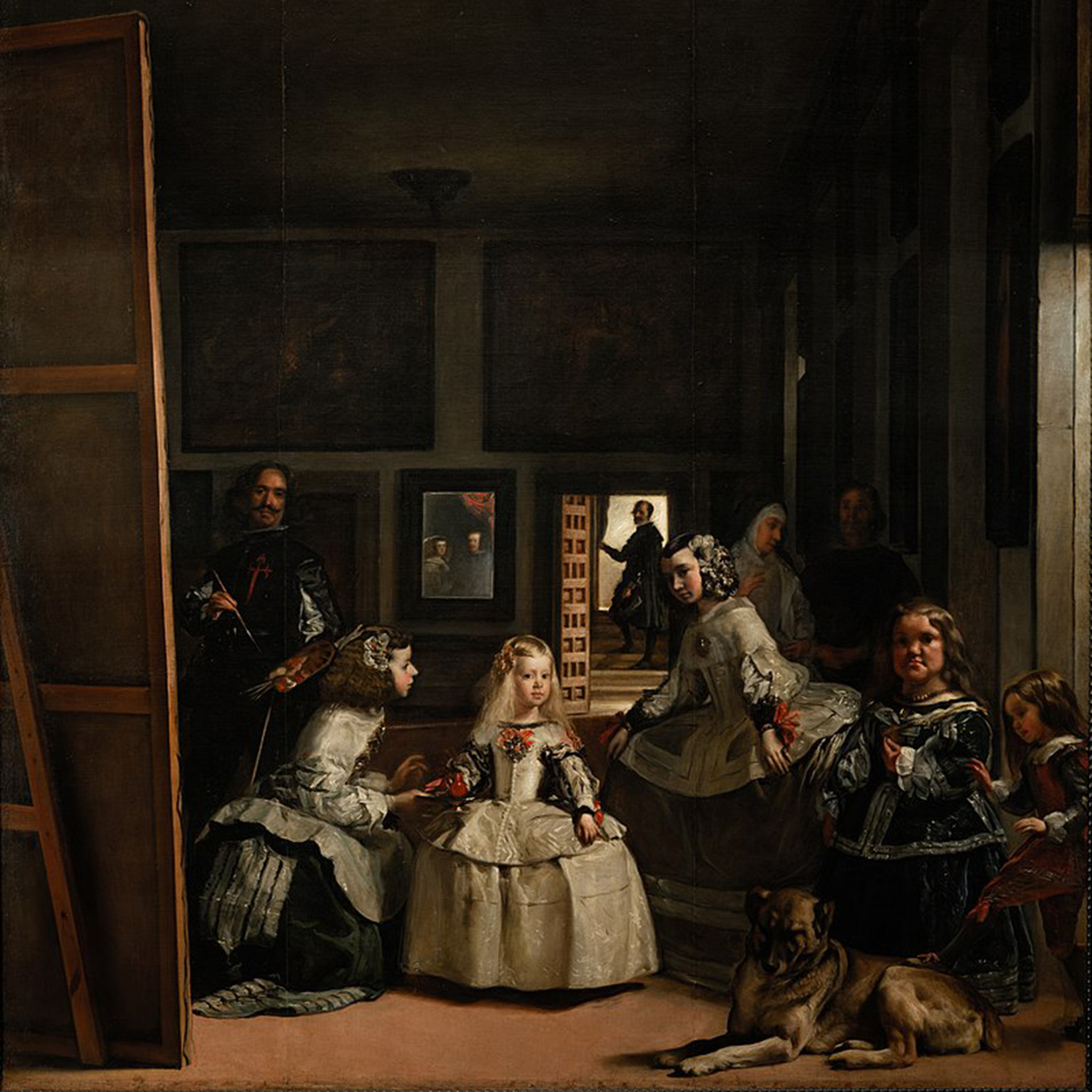
Las Meninas is an oil-on-canvas masterwork of the Spanish Golden Age. Diego Velázquez painted this composition in 1656, at the peak of his career as a painter in the court of King Philip IV of Spain.
The scene takes place in a room of the Madrid Alcázar and features Infanta Margaret Theresa with her entourage, and Velázquez himself appearing to paint the royal couple. The artist’s intricate portrayal of court life highlights the complexity of the human gaze while adding an element of spatial uncertainty. Its nuanced interplay of reflections and viewpoints blurs the boundaries between the viewer and the subjects. The painting is often referred to as a genre scene because it depicts a moment of everyday life along with the spontaneity and informality of the subjects.
Las Meninas’ value is beyond monetary assessment, as it is considered one of the most analyzed works of Western art. However, other works by Velázquez have sold for $5 – $10 million at art auctions.
Today, Las Meninas is part of the collection of the Museo del Prado in Madrid, Spain.
4. The Birth of Venus by Sandro Botticelli, 1486
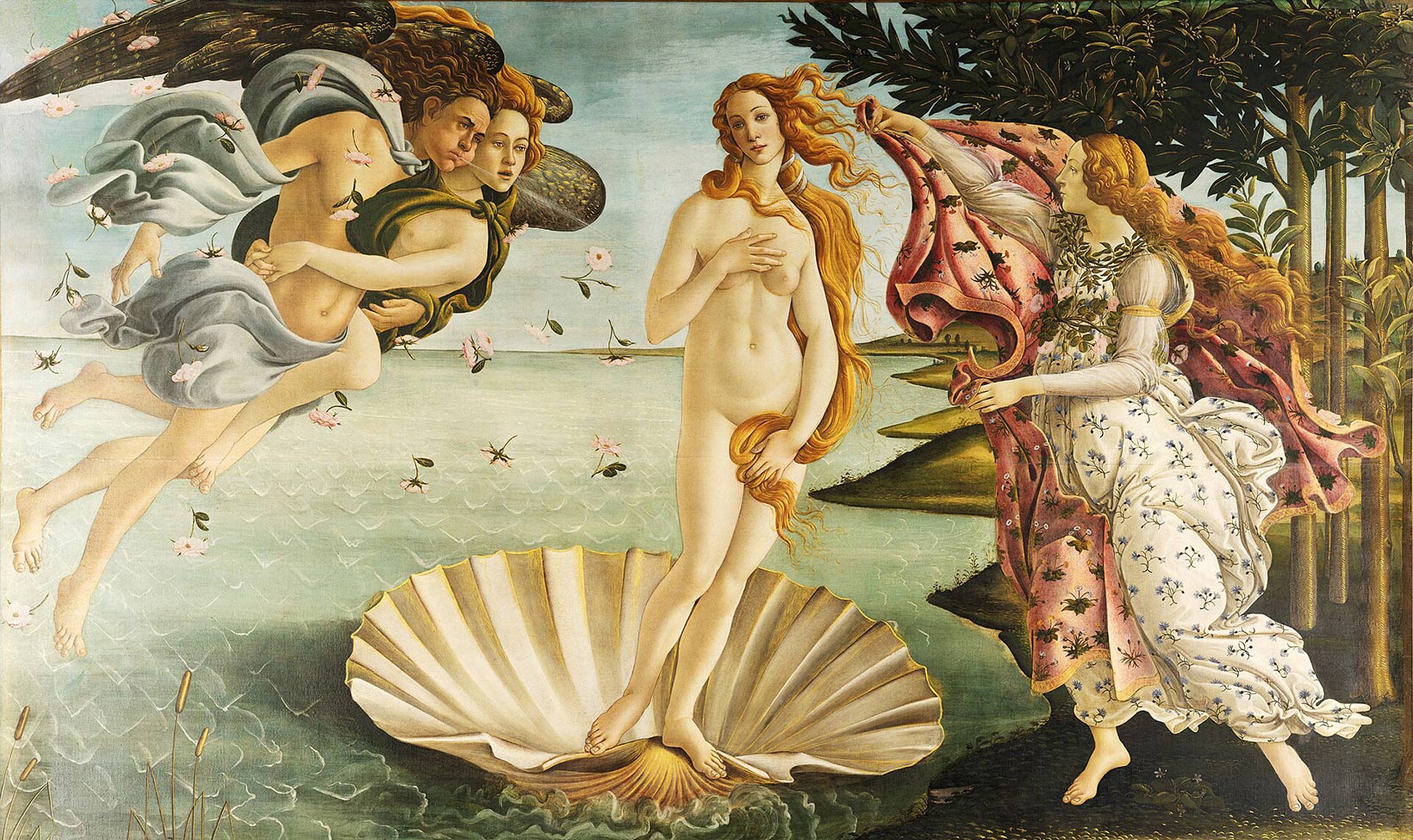
The Birth of Venus embodies the Early Renaissance style and stands out for its mythological subject matter. Sandro Botticelli depicted Venus, the Roman goddess of love, arriving ashore on a shell using tempera on canvas.
Sandro Botticelli completed this iconic painting around 1486, a time when religious themes dominated the world of art. Botticelli instead ventured into the realm of classical mythology to portray Venus’s emergence from the sea, an allegory drawn from Homeric hymns and Ovid’s “Metamorphoses.” As a mythological scene, The Birth of Venus is thus a departure from the prevalent religious subjects of the time, and a reflection of the humanist ideals of the Renaissance. The painting is thought to symbolize both spiritual and earthly love.
It’s impossible to ascribe monetary value to a monumental piece of cultural heritage such as The Birth of Venus. That said, Botticelli’s other works have fetched as much as $100 million at art auctions in the past.
Presently, The Birth of Venus is displayed at the Uffizi Gallery in Florence, Italy.
5. The Kiss by Gustav Klimt, 1907–1908
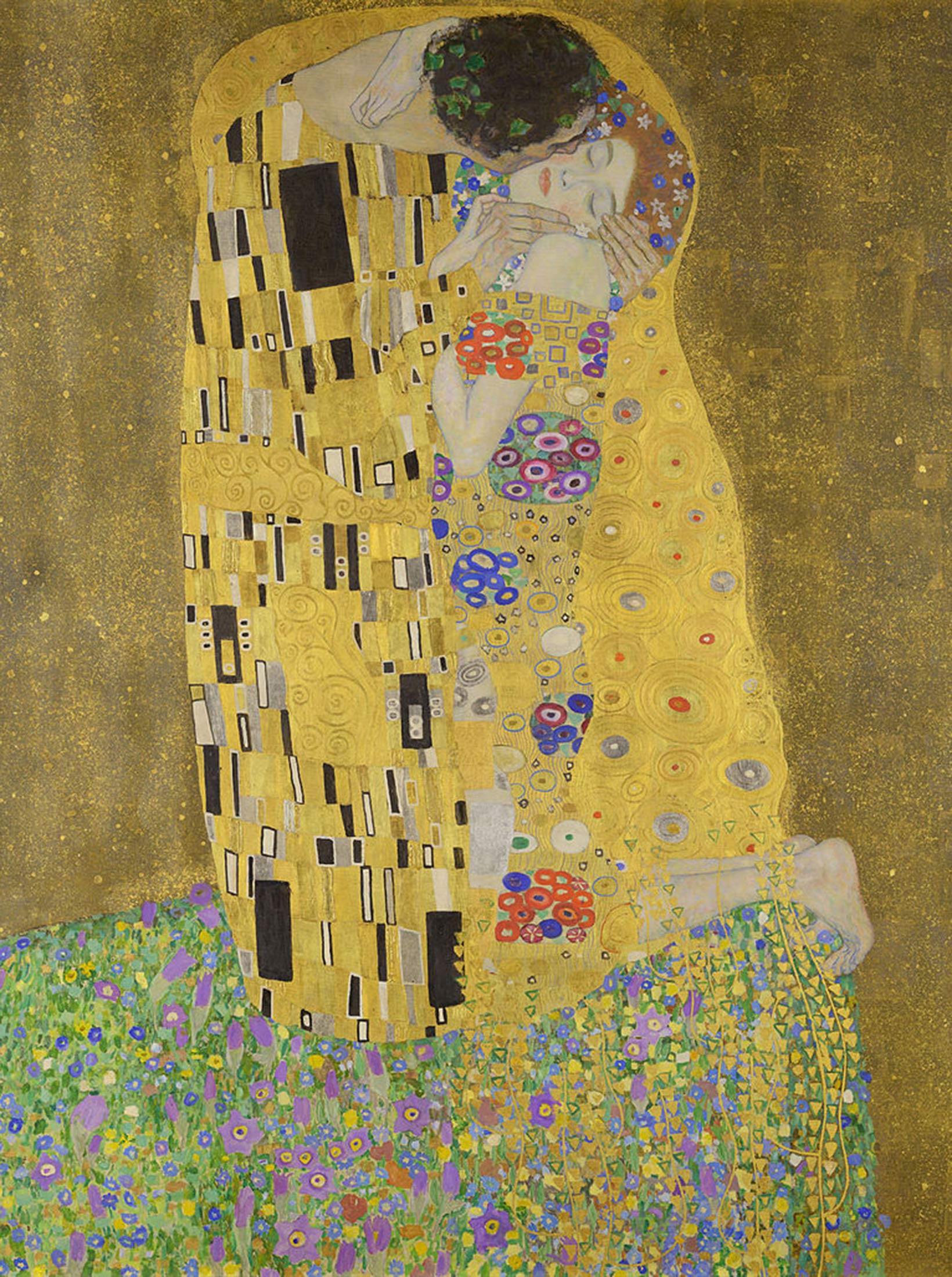
The Kiss is a hallmark of Gustav Klimt’s “golden phase,” which was known for its use of gold leaf, ornate patterns, and sensuous forms. This oil-and-gold-leaf-on-canvas symbolist work captures an intimate moment between two lovers, wrapped in a decorative blanket that glimmers with gold – a signature of Klimt’s style.
Gustav Klimt created this iconic piece between 1907 and 1908, during a period when he was heavily influenced by the Art Nouveau movement. The painting’s focus on a romantic and erotic subject matter characterized Klimt’s own exploration of love and relationships.
The financial value of The Kiss is impossible to pinpoint, and experts often describe the painting as invaluable due to its artistic significance. That said, Klimt’s other famous works have sold for over $100 million at auctions.
The Kiss presently has its place in the Österreichische Galerie Belvedere museum in Vienna, Austria.
6. The Garden of Earthly Delights by Hieronymus Bosch, 1500-1510
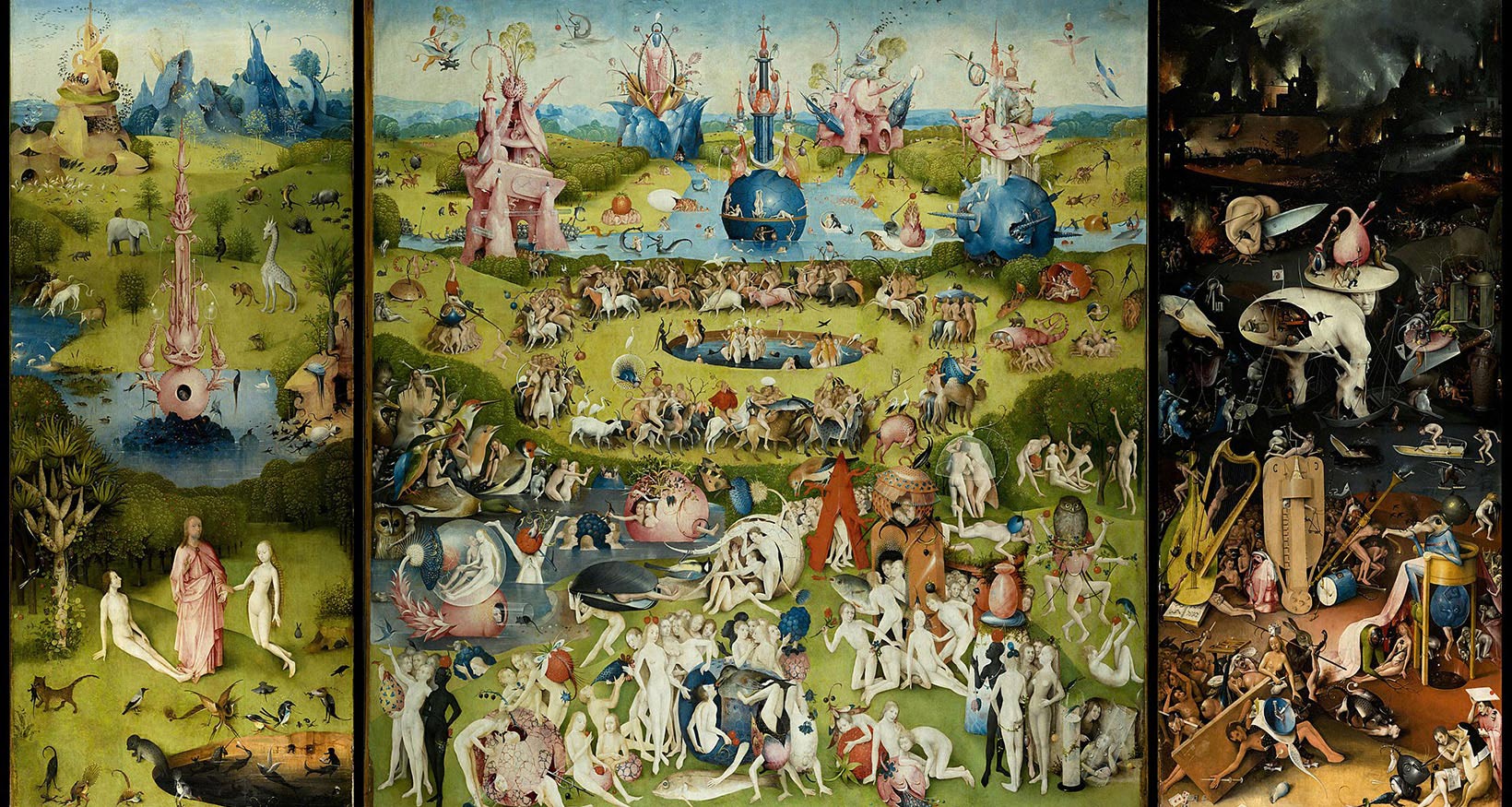
The Garden of Earthly Delights is an iconic Northern Renaissance triptych that’s known for its elaborate and fantastical imagery. Dutch painter Hieronymus Bosch used oil on oak panels to create this work, which unfolds in three parts: The Garden of Eden, a central panel of earthly pleasures, and a hellish landscape.
Hieronymus Bosch crafted The Garden of Earthly Delights between 1500 and 1510, a time when such religious allegories were common in Northern European art. The triptych uses a vivid and complex visual language to explore themes of temptation, sin, and judgment. The work is celebrated for its imaginative and often surreal depiction of biblical and moral narratives.
The value of the painting is immense in cultural, but incalculable in monetary terms.
Today, The Garden of Earthly Delights resides in the Museo del Prado in Madrid, Spain.
7. The Last Supper by Leonardo Da Vinci, 1495—1498

The Last Supper is a defining work of the High Renaissance that showcases Leonardo da Vinci’s mastery in composition and perspective. This tempera-and-oil-on-plaster mural depicts the moment Jesus announces that one of his disciples will betray him, and captures the emotional responses of each apostle.
Leonardo da Vinci painted The Last Supper between 1495 and 1498, in the Convent of Santa Maria delle Grazie in Milan. This work falls under the religious genre, illustrating a pivotal moment from the Christian narrative. However, the painting represents a significant shift from traditional Last Supper depictions. Where older portrayals of Jesus’s fateful dinner were static and formal, Da Vinci’s rendition breathed life into the subjects by giving the men at the table realistic emotional expressions.
The Last Supper has gone through numerous restorations due to innate issues with the medium, the technique used, and the environmental factors. Da Vinci used the dry fresco technique, which entails applying tempera and oil paint directly onto a dry wall. This method resulted in poor adhesion and flaking of the paint over time. Additionally, environmental factors like humidity and temperature fluctuations have exacerbated the painting’s deterioration.
The Last Supper remains in its original location in Milan, where it continues to be one of the most studied and revered paintings in art history. The painting is invaluable, and would be impossible to relocate were it ever sold.
8. The Creation of Adam by Michelangelo Buonarroti, 1511

The Creation of Adam is a celebrated religious artwork that incarnates the grandeur of the High Renaissance and symbolizes the relationship between man and God. In this fresco, Michelangelo Buonarroti depicts the biblical narrative of God giving life to the first man, Adam, with a simple yet powerful touch.
Michelangelo produced The Creation of Adam in 1511 as part of the Sistine Chapel’s ceiling in Vatican City. The painting is renowned for its imposing composition and the galvanizing depiction of the moment when God bestows life upon Adam through their nearly touching hands. The painting reflects Michelangelo’s profound understanding of anatomy and his ability to capture the essence of the human spirit.
Today, The Creation of Adam adorns the Sistine Chapel’s ceiling, where it continues to be a focal point for millions of visitors. The monetary value of the fresco is impossible to estimate, and the piece would be impossible to sell since it forms part of the cathedral.
9. Blue Dancers by Edgar Degas, 1897
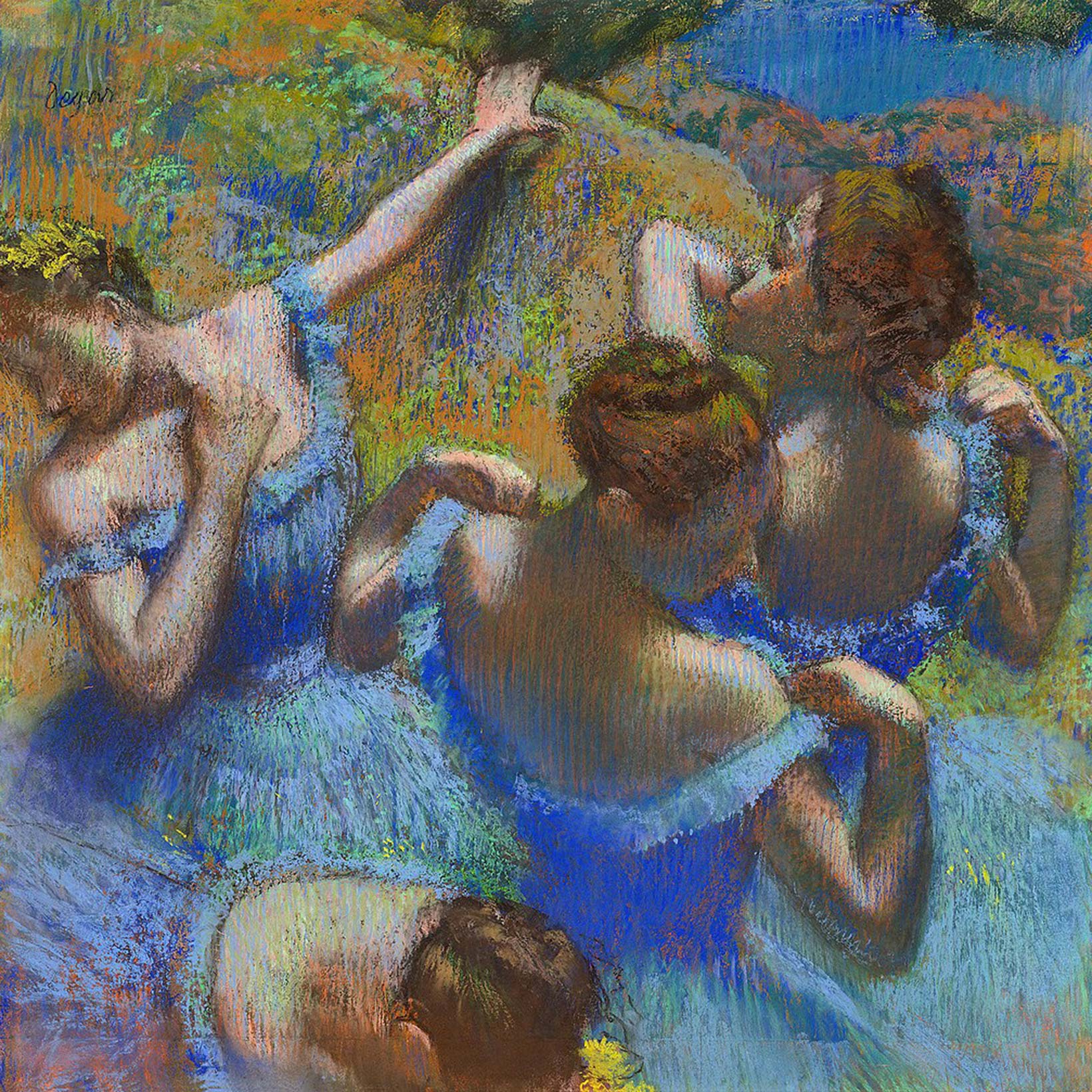
Blue Dancers is a notable work by Edgar Degas that exemplifies the Impressionist movement with a vibrant portrayal of movement and light. Degas used pastel on paper to capture the fluidity and grace of a group of ballerinas wearing blue tutus in various stages of movement.
Degas created the Blue Dancers in 1897. The artist’s focus on fleeting moments of motion marked a significant departure from traditional artistic conventions of his time. Additionally, Blue Dancers sheds light on the Parisian cultural scene of the late 19th century by capturing the fascination and charm of the ballet, which was a significant part of life in Paris at the time.
The monetary worth of the Blue Dancers is difficult to estimate. However, Sotheby’s estimates for similar works by Degas hover in the $18-$25 million range.
Currently, Blue Dancers forms part of the collection at the Musée d’Orsay in Paris, France.
10. The Persistence of Memory by Salvador Dalí, 1931

The Persistence of Memory is a seminal Surrealist work by Salvador Dalí that is renowned for its dream-like imagery and thought-provoking themes. Dalí utilized oil on canvas to depict a fantastical landscape with melting clocks, reflecting his deep interest in the concept of time and the subconscious mind.
Dalí created this iconic piece in 1931, a time when contemporary physics theories hinted at the fluidity of time. The painting is thus often interpreted as a representation of the relativity of space and time. Dalí’s meticulous technique and striking use of color and form bring a dreamlike quality to the painting, blurring the lines between reality and fantasy.
The painting’s value extends beyond monetary worth, as it is regarded as a landmark in 20th-century art. However, Dalí’s other works have fetched prices ranging between $1-$20 million at auctions.
Today, this masterpiece is housed in the Museum of Modern Art in New York City.
11. Liberty Leading The People by Eugene Delacroix, 1830

Liberty Leading the People is a defining piece of Romantic art that portrays the July Revolution of 1830 in France. Eugene Delacroix used oil on canvas to capture the allegorical figure of Liberty leading a charge over the barricades.
Eugene Delacroix painted this work in 1830, the year of the July Revolution. The painting vividly illustrates the fight for liberty, portraying figures from different social classes united under the cause of the revolution. Liberty is the central figure, who is depicted as a bare-breasted woman holding the French tricolor. This portrayal draws from classical imagery, where bare breasts were often used to represent purity, nurturing, and the birth of ideas. Delacroix’s imagery in this painting powerfully conveys the raw, unadorned passion and bravery of the people rising against oppression.
The value of Liberty Leading the People is immeasurable in monetary terms because of its enormous historical and political significance. That said, other works by Delacroix have sold for almost $10 million in the past.
Today, the painting is displayed in the Louvre Museum in Paris.
12. Girl with A Pearl Earring by Johannes Vermeer, 1665
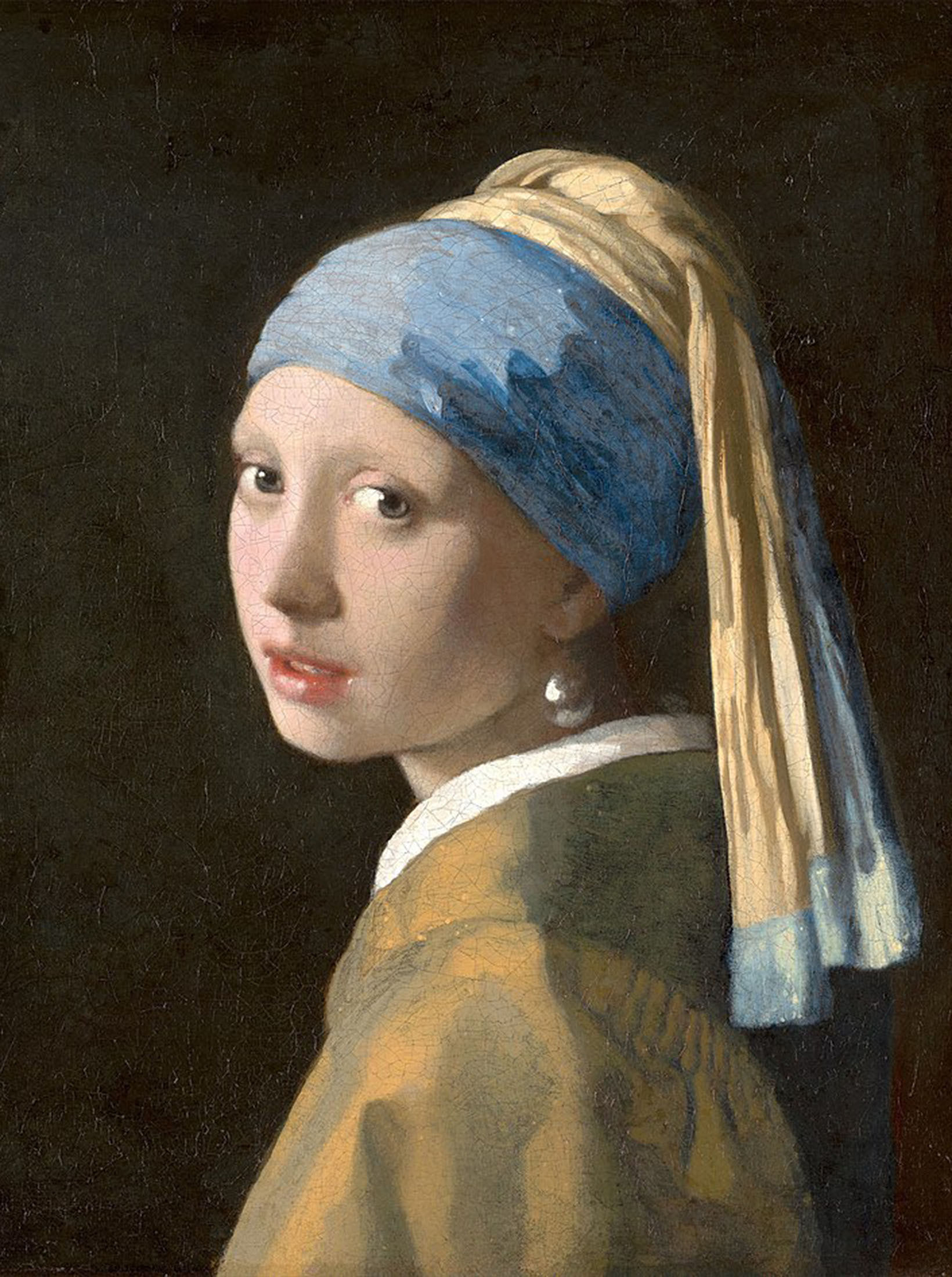
Girl with a Pearl Earring is a Dutch Golden Age tronie that’s renowned for its simplicity and depth of expression. Johannes Vermeer used oil on canvas to paint this masterpiece.
Vermeer created this famous tronie around 1665. The subject (often referred to as the “Mona Lisa of the North”) is a young girl wearing an oversized pearl earring. The artist made subtle use of light and shadow to lend a lifelike quality to the girl’s face and the pearl. The painting’s striking realism and the enigmatic look of the girl depicted contribute to the lasting allure of the piece.
It’s difficult to ascribe monetary value to the Girl with a Pearl Earring without a bidding process at an art auction. However, other Vermeer works have been sold for, or are valuated at, astronomical prices. For example, A Young Woman Seated at the Virginals sold for $40 million Canadian dollars in the early 2000s. Meanwhile, Vermeer’s missing painting, The Concert, is valued at $250 million USD.
Currently, Girl with a Pearl Earring is housed in the Mauritshuis Museum in The Hague, Netherlands.
13. The Night Watch by Rembrandt Van Rijn, 1642

The Night Watch is a masterpiece of Baroque art that’s famous for its dynamic use of light and shadow and its sense of movement. Rembrandt employed oil on canvas to create this large-scale painting, which depicts Captain Frans Banninck Cocq and his lieutenant, Willem van Ruytenburch, leading a city militia.
Rembrandt completed this work in 1642. The painting features the use of chiaroscuro, a technique that contrasts light and dark to achieve a sense of volume. The figures in The Night Watch are set against a dark background, with strategic lighting highlighting their movement and expressions. The Night Watch is traditionally classified as a militia painting, a common genre in Dutch Golden Age art. However, the piece transcends this categorization with its dramatic and lively depiction of the guards.
Establishing the current monetary value of The Night Watch is impossible without an auction. However, similar works by Rembrandt have fetched prices between $140-$180 million in the past.
Today, The Night Watch is a centerpiece at the Rijksmuseum in Amsterdam, Netherlands.
14. The Return of The Prodigal Son by Rembrandt, 1661–1669

The Return of the Prodigal Son is a poignant example of Baroque religious art that highlights Rembrandt’s mastery in portraying human emotion and spirituality. Rembrandt used oil on canvas to depict the biblical story of the prodigal son returning to his father, a theme of forgiveness and redemption that had long captivated the painter.
Rembrandt painted this work in the final years of his life, between 1661 and 1669. The Return of the Prodigal Son is noted for its dramatic use of light and shadow, a contrast emphasizing the moving reunion between the repentant son and his compassionate father. The painting stands out for its profound exploration of human emotions, particularly guilt, sorrow, and forgiveness. This focus on emotional depth and moral complexity is a hallmark of Rembrandt’s later works.
The Return of the Prodigal Son holds immense value, both for its artistic brilliance and its deep spiritual significance. Its monetary cost is difficult (if not impossible) to estimate. However, other Rembrandt works have sold for hundreds of millions of dollars at recent auctions.
The painting is presently displayed at the State Hermitage Museum in Saint Petersburg, Russia.
15. Christ Carrying The Cross by El Greco, 1580

Christ Carrying the Cross is a distinguished work of Mannerism characterized by El Greco’s unique style of elongated figures and emotional intensity. This oil-on-canvas painting depicts Jesus Christ bearing the cross on his way to Calvary.
El Greco (born Domenikos Theotokopoulos) created this piece around 1580 while residing in Toledo, Spain. The artist’s portrayal of Christ emphasizes his spiritual suffering and divine nature. The painting’s vivid colors and fluid, almost surreal form lend it a sense of motion and emotional depth.
The value of the Christ Carrying The Cross is immeasurable. However, other paintings by El Greco have fetched as much as $14 million.
Today, the painting is housed at the Metropolitan Museum of Art in New York City.
16. Landscape with The Fall of Icarus by Pieter Bruegel The Elder, 1560
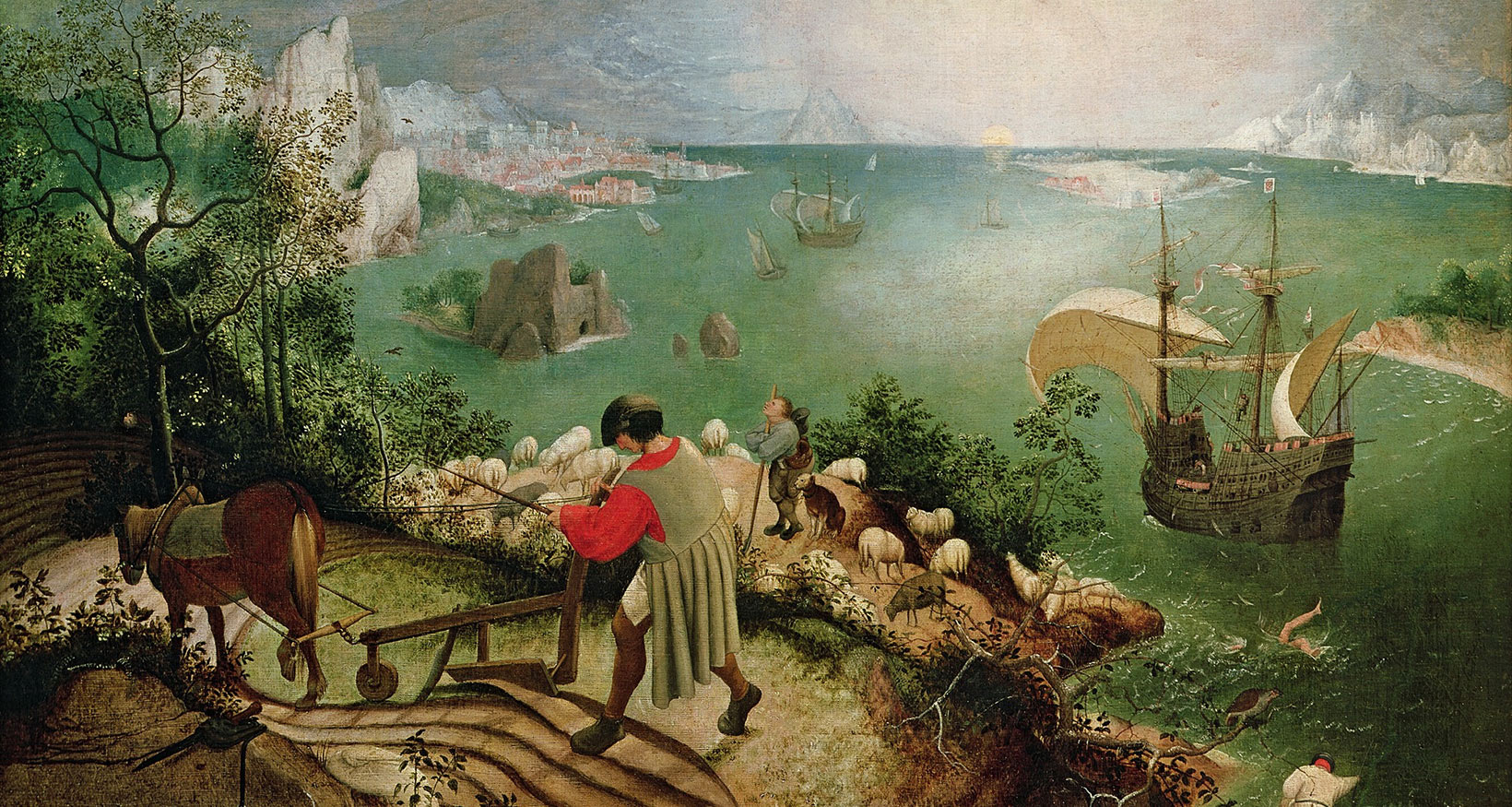
Landscape with The Fall of Icarus is a significant Northern Renaissance landscape by Pieter Bruegel the Elder. The painting depicts Icarus’s plunge into the sea with the foreground featuring an indifferent world and ordinary people going about their daily lives unaware of the tragedy.
Bruegel crafted this artwork around 1560, using oil on canvas. The painting is renowned for its juxtaposition of the dramatic myth of Icarus, who fell from the sky after flying too close to the sun, with its mundane, everyday setting. The masterpiece has gained immense value over the centuries and is celebrated for its nuanced commentary on human nature and the relationship between myth and reality.
The monetary value of Landscape with The Fall of Icarus is difficult to estimate. However, other works by Pieter Bruegel the Elder have sold for over $5 million at past art auctions.
Presently, the artwork is part of the collection at the Royal Museums of Fine Arts of Belgium in Brussels.
17. The Ancient of Days by William Blake, 1794
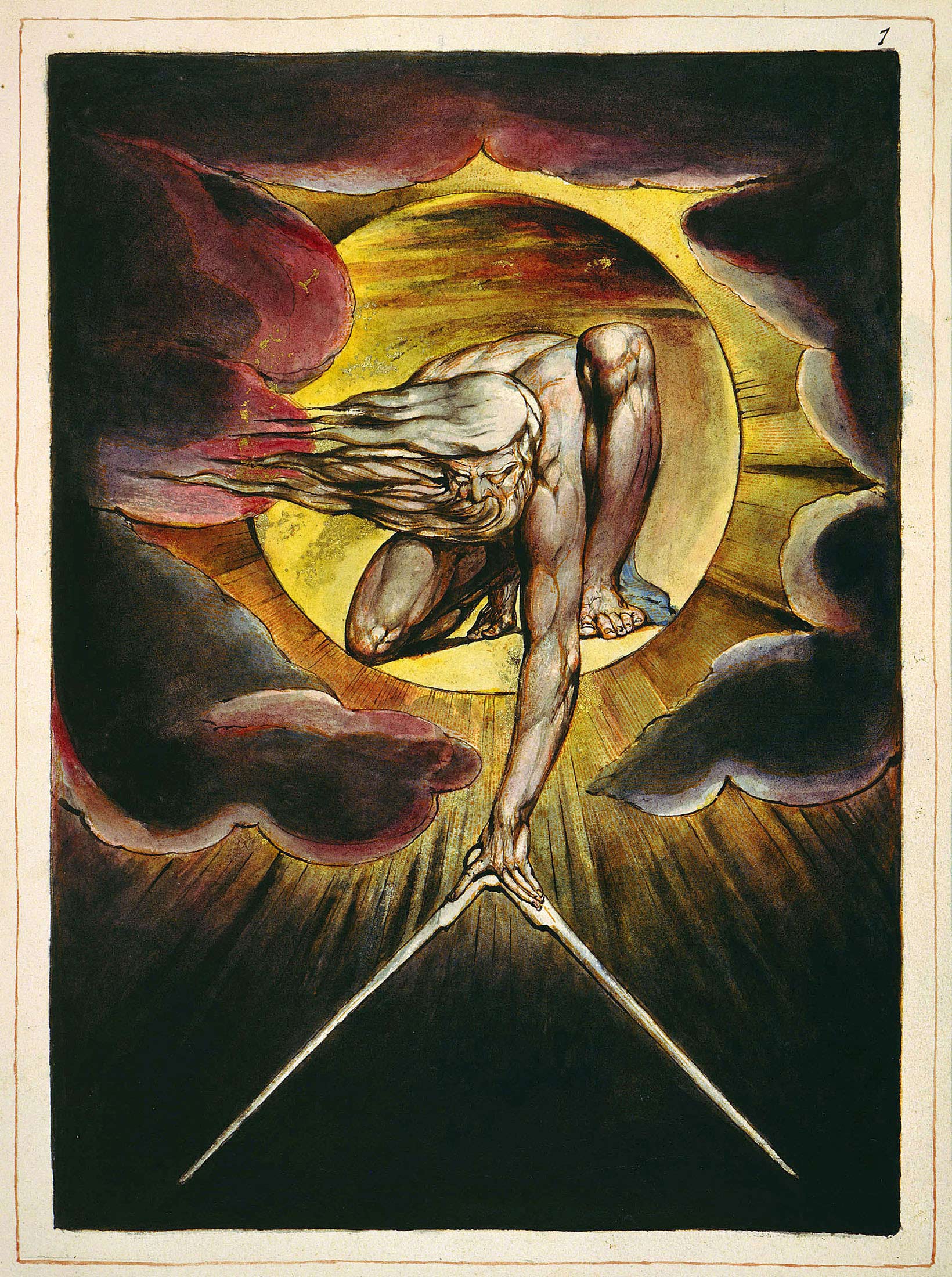
The Ancient of Days is a seminal piece of Romantic symbolism that epitomizes William Blake’s unique style in a fusion of mystical and biblical elements. Blake crafted this piece using watercolor and etching, depicting a godlike figure setting a compass upon the void, symbolizing creation.
William Blake created this iconic work in 1794 as a frontispiece for his Europe a Prophecy book. The painting is widely interpreted as portraying Urizen, Blake’s mythological figure that embodies reason and law. The outstretched arm and compass of Urizen evoke the themes of divine creation and cosmic order.
The Ancient of Days holds significant value, although its monetary worth is difficult to appraise outside of an auction. That said, the realized prices for Blake’s paintings have ranged up to $4 million.
The original watercolor of “The Ancient of Days” is currently housed in the British Museum in London, England.
18. The Tower of Babel by Pieter Bruegel The Elder, 1563
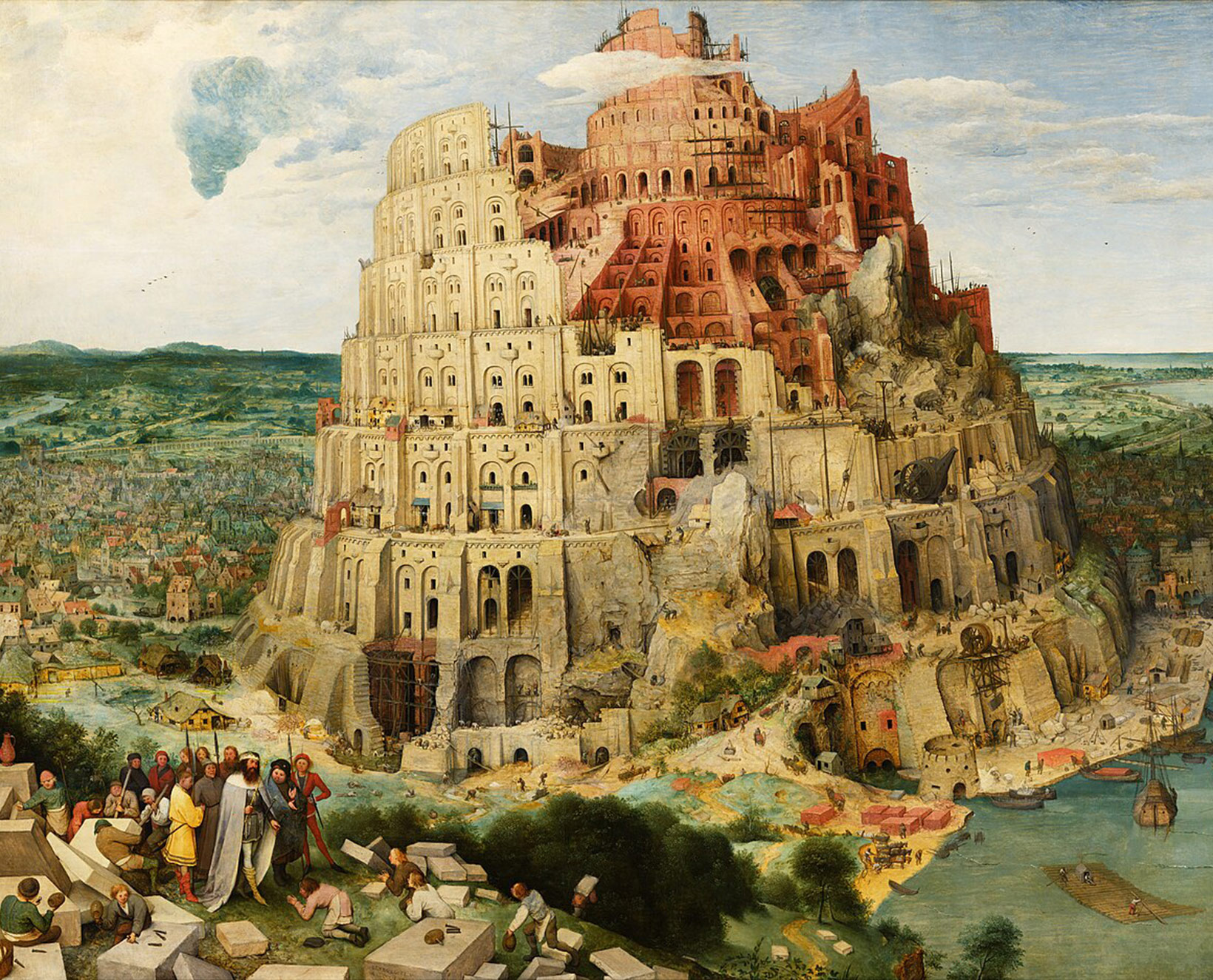
The Tower of Babel refers to a set of two prominent Northern Renaissance religious artworks that showcase Pieter Bruegel the Elder’s skill in narrative and landscape painting. The oil-on-panel pieces illustrate the immense scale and the bustling activity around the construction of the Tower of Babel according to Biblical legend.
Pieter Bruegel the Elder had painted three versions of The Tower of Babel. The artist created the first version in 1552-1553, but this original piece is now lost. The remaining two depictions of the tower (known as “The Little” and “The Great”) were painted in 1563. The paintings are renowned for their intricate detailing and the portrayal of the tower, which dominates the landscape. Bruegel’s representations of the Tower of Babel are also a commentary on human ambition and diversity, as evidenced by the various figures and activities the painting depicts. Apart from their religious narrative, the pieces serve as a reflection of the societal and architectural interests of the 16th century.
The worth of the two original versions of Bruegel’s The Tower of Babel is impossible to estimate. However, a version of the Great Tower of Babel painted by the artist’s son, Peter Bruegel the Younger, fetched $2.6 million at a Christie’s auction in 2022.
Today, The Great Tower of Babel is housed in the Kunsthistorisches Museum in Vienna, Austria. Meanwhile, The Little Tower of Babel resides at the Museum Boijmans Van Beuningen in Rotterdam, Netherlands.
19. The School of Athens by Raffaello Santi, 1509–1511
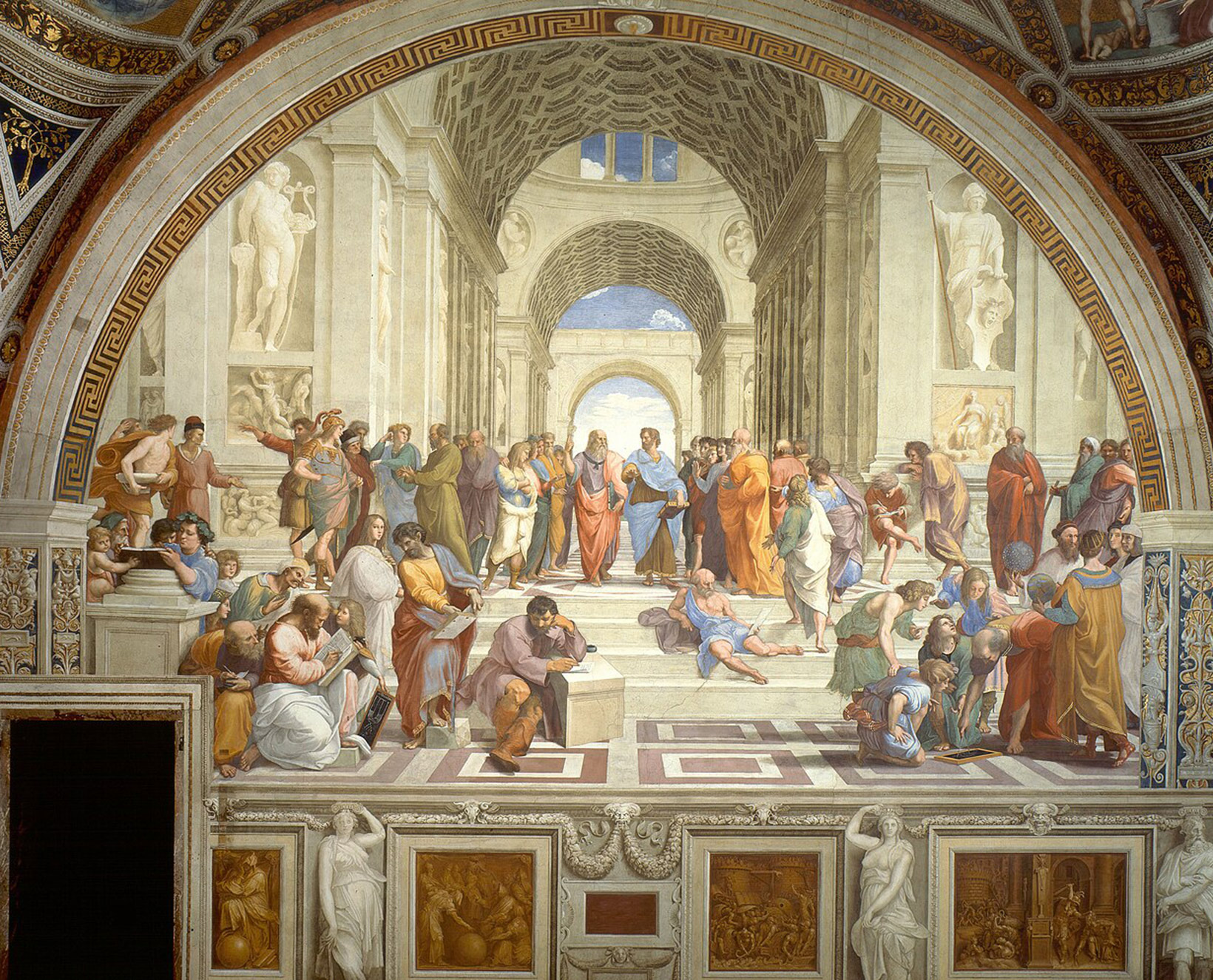
The School of Athens is a quintessential historical artwork of the High Renaissance, painted by Raffaello Santi (better known as “Rafael”). This fresco presents an assembly of ancient Greek philosophers and scientists and symbolizes the intellectual achievements of the classical world.
Raphael created this fresco between 1509 and 1511 as part of a commission to decorate the Stanze di Raffaello in the Vatican. The painting features prominent figures like Plato and Aristotle at its center, surrounded by other prominent thinkers engaged in various activities. Raphael’s use of perspective and his ability to imbue each figure with individuality showcase the artist’s mastery of composition and make this work a masterpiece of Renaissance art.
The fresco’s cultural, historical, and monetary value is immeasurable, as it represents one of the highest points in Renaissance art. Regardless, the fresco couldn’t ever be sold because it adorns the walls of the Apostolic Palace in the Vatican, and is thus part of a building.
20. The Madonna Litta by Leonardo Da Vinci, 1491
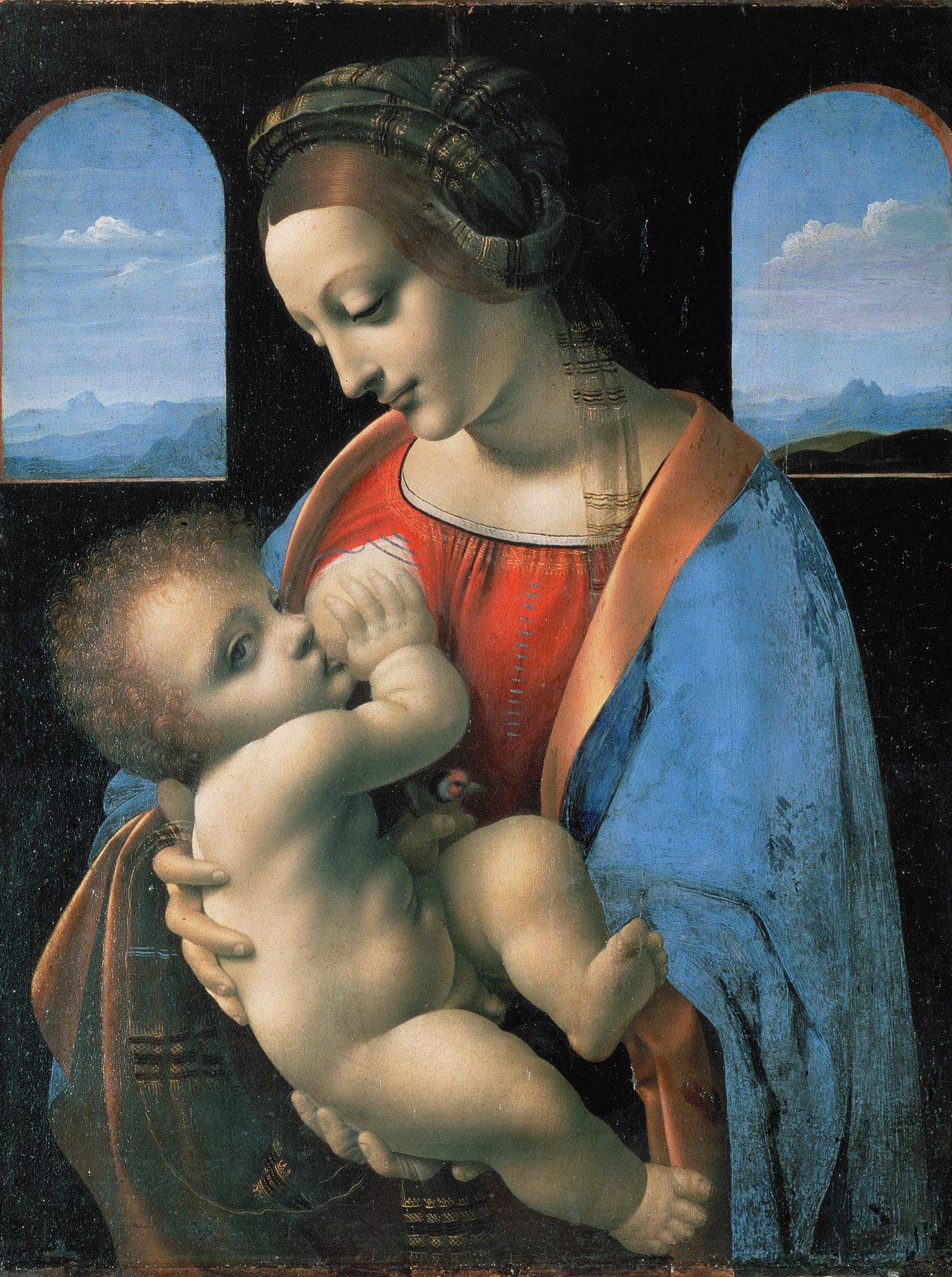
Madonna Litta is an exemplary piece of High Renaissance religious art attributed to Leonardo da Vinci and his workshop. This tempera-on-canvas painting captures a tender moment between the Madonna and the Christ Child, who is depicted breastfeeding. The artwork is celebrated for its delicate portrayal of motherly affection and the serene expressions of its subjects.
Leonardo da Vinci is believed to have created the Madonna Litta around 1491. The painting’s precise brushwork, attention to detail, and the soft, naturalistic rendering of the figures are characteristic of Leonardo’s style. The intimate and human depiction of the subject reflects the Renaissance emphasis on realism and emotional expression.
The painting’s value extends far beyond monetary worth as it represents a significant piece of Renaissance art history. However, Da Vinci’s paintings are some of the most expensive in the world, with Salvador Mundi fetching a record-breaking $450 million at an auction.
Today, The Madonna Litta is housed in the Hermitage Museum in Saint Petersburg, Russia.
What does art mean?
Art is an umbrella term that encapsulates a diverse range of human makings and ways of expression and includes visual, auditory, and performance creations. However, the terms “art” and “painting” specifically refer to the creation of visual compositions using mediums such as paint on various surfaces. Visual art may express ideas, and emotions, or serve as a visual representation of the world.
Classical art encompasses the art forms that stemmed from ancient Greece and Rome and extended to the Renaissance period. This art type emphasizes harmony, balance, and a deep respect for humanism. These principles manifest in classical paintings, in which artists meticulously portray the human form, landscapes, and narratives, striving for realism and emotional depth. Paintings from this era often reflect a combination of technical skill, rich symbolism, and allegories representing philosophical or religious concepts.
The expanded definition of art transcends aesthetic appreciation or skillful execution. On a broader scale, art is a vehicle for expression, a reflection of cultural and historical epochs, and a medium for challenging perspectives. Through various forms like “art painting” and “classical art,” it bridges the gap between the tangible and the abstract and provides a platform for dialogue, innovation, and introspection.
Why is art important in history?
Art is important in history because it serves as a visual record of the societies and eras from which it originates. In particular, art captures three distinct and historically significant nuances of its time.
Firstly, artworks reflect the beliefs and ideals of the times in which they were created. For example, Renaissance art reveals the era’s shift towards humanism and realism, while Baroque art mirrors the dramatic intensity of the period. Visual art captures the nuances of societal changes, technological advancements, and philosophical evolutions that might be less apparent in written records.
Secondly, art provides a personal, emotional connection to the past. It conveys the hopes, fears, and passions of different civilizations, thus giving us an intimate understanding of our ancestors. This connection gives us a deeper comprehension of how past societies functioned and what they deemed significant.
Finally, art reflects the national and cultural identities of the past. Art may represent a form of resistance, a tool for propaganda, or a medium to celebrate cultural achievements.
How to classify different types of art?
To classify different types of art, one must understand the various criteria used to categorize artworks.
Begin by considering the medium. This includes painting, sculpture, photography, and digital art. Each medium branches out with further distinctions based on technique and materials, such as oil painting versus watercolor, or marble sculpture versus bronze casting.
Next, consider the style or movement the art belongs to. There are numerous art movements throughout history, including Renaissance, Baroque, Impressionism, Cubism, and Modernism, each with unique characteristics and philosophies.
The genre of the artwork is the next classification criterion. Genres in art include landscapes, portraits, still lifes, and historical paintings. Each genre has its conventions and focal points, like the human form in portraiture or natural scenery in landscapes.
Another way to classify art is by its purpose or function. For example, an artwork may be decorative, with no function other than beautifying a space. Conversely, a piece of art may be conceptual, meaning that it aims to convey complex ideas and provoke thought.
Finally, artworks are often classified based on the region or culture they originate from, like African art, Asian art, or Western art. Art from each of these regions has distinct characteristics that stem from their cultural contexts.
What type of art is the Mona Lisa?
The Mona Lisa is a portrait from the Renaissance period. The piece was produced between 1503 and 1506 (toward the end of the Renaissance era) and features the portrait of a human subject.
In this period, a renewed interest in classical ideals, realism, and the exploration of humanistic themes characterized art. Mona Lisa exemplifies these Renaissance traits through its detailed depiction of the human form and the use of sfumato, a subtle technique that blends colors to create lifelike textures and depth. Da Vinci’s portrayal of the subject reflects the era’s emphasis on capturing human emotions and expressions in visual art.
What type of art is The Last Supper?
The Last Supper is a Renaissance mural painting by Leonardo da Vinci. This iconic work was created using tempera-and-oil-on-plaster in 1498, during the height of the Renaissance period.
In The Last Supper, Leonardo showcases realism and humanistic values, both hallmarks of Renaissance art. The mural captures a significant biblical scene with dramatic and emotional depth, thus reflecting the Renaissance era’s focus on religious themes conveyed with a human-centered approach. The Last Supper’s portrayal of the apostles’ varied reactions to Christ’s revelation of betrayal demonstrates the Renaissance’s approach to expressing human emotions and narratives in art.
What type of art is The Starry Night?
The Starry Night is a Post-Impressionist landscape painting by Vincent van Gogh. Van Gogh created the masterpiece in 1889, just as Post-Impressionism was taking root in France. The artwork depicts a landscape comprising a village and the surrounding countryside under a night sky.
Van Gogh’s use of vivid color, thick brushstrokes, and dramatic, swirling forms in The Starry Night creates a dynamic interpretation of the landscape, characteristic of Post-Impressionism. The painting moves beyond the realist landscapes of Impressionism and offers a deeper, subjective reflection of the artist’s mind and mood.
How can famous art paintings be adapted into art installations?
Famous art paintings can be adapted into art installations by transforming their visual elements or concepts into three-dimensional, interactive, or immersive environments. Art installations are large-scale constructions or assemblies in a space, designed to interact with their surroundings and engage the audience in a multi-sensory experience.
To adapt a painting into an art installation, artists often expand upon the painting’s narrative, style, or key elements, thus creating a physical space that offers viewers a new perspective or experience.
Below are three examples of paintings that have been adapted into art installations.
- Andy Warhol’s The Last Supper: Andy Warhol transformed Leonardo Da Vinci’s religious painting into a series of pop artworks. These paintings reinterpreted the original mural with pop iconography, showcasing how classical themes can be given a contemporary twist.
- Tobias Stengel’s Die Woge: This is a sculptural interpretation of Katsukisha Hokusai’s “The Great Wave off Kanagawa.” Stengel’s work commemorates the flooding of the Elbe River by transforming Hokusai’s famous woodblock print into a three-dimensional sculpture.
- Roy Lichtenstein’s Bedroom at Arles: Lichtenstein reimagined Vincent Van Gogh’s “Bedroom at Arles” in his distinctive pop art style. The work imposes Lichtenstein’s graphic aesthetic on Van Gogh’s original and highlights the ability of different artistic styles to provide new perspectives on the same subject matter.

